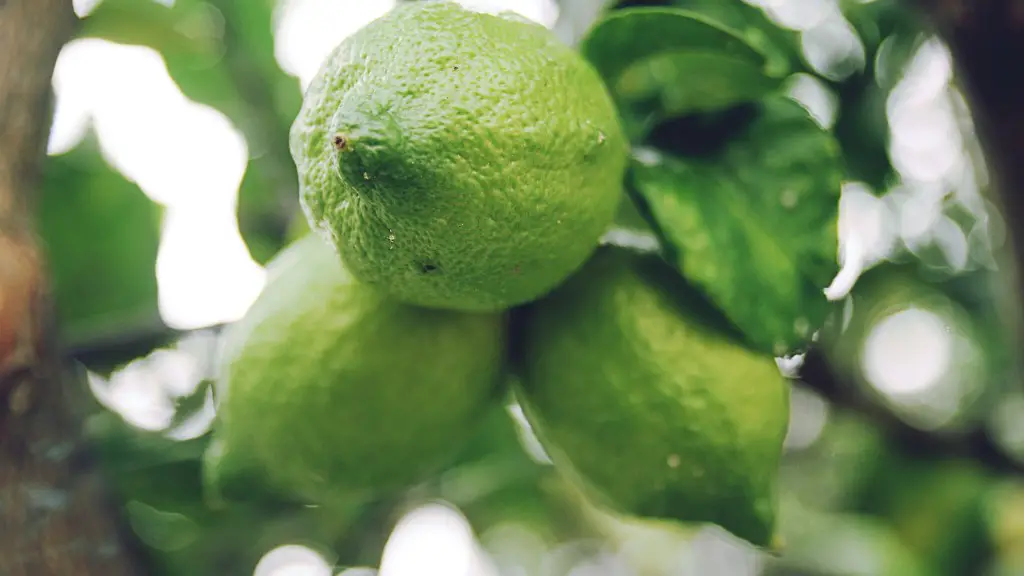Climate Requirements for Growing an Avocado Tree
Avocado trees are easy to grow and require very basic care and maintenance. They prefer a Mediterranean climate, growing best in warm climates but can tolerate cold temperatures as low as 27F/-3C. The tree prefers full sun and a well-drained soil. Avocado trees require frequent watering to keep the soil moist, but over-watering can lead to root rot.
For optimal growth and fruit production, the tree should be pruned annually to control the size and keep it to an optimal balance of branches and foliage. Doing so will also help to promote upright growth and a shapely, attractive form. The tree should also receive regular fertilizing during the growing season—according to the instructions on the package or by an experienced gardener.
How Long Does It Take for an Avocado Tree to Produce Fruit?
Avocado trees can take anywhere from three to six years to mature. Depending on the type of avocado tree, the tree can take anywhere from three to five years to produce fruit—this includes ‘Fuerte’, ‘Sharwil’, and ‘Bradycarpa’. The length of time it takes for an avocado tree to produce fruit can be affected by climate and the type of soil. It can even be affected by the frequency of flowering, pollination, and the overall care the tree receives during its life.
To encourage the best and most consistent fruit production, the tree should be kept in ideal temperatures between 45F to 85F/7C to 29C and should be watered frequently and with the right mix of nutrients. The tree should also be pruned and pruned correctly to promote the proper balance of branches, foliage, and fruit.
Can an Avocado Tree Produce Without Pollination?
Avocados are in the Lauraceae family, which is composed of hermaphroditic flowers, meaning the flowers on the avocado tree produce both male and female structures for reproduction. Although these flowers don’t require cross-pollination for fruit production, it does help to speed up the process when the pollen from one avocado tree is used to pollinate another.
When a tree is receiving sufficient pollination, you’ll typically find it displaying flowers that are turning into fruits. It should also have at least one or two fruits on it at all times, depending on the variety. Without pollination, the production of fruit may be delayed and the fruits may be small and not of the highest quality.
What is the Best Time to Plant an Avocado Tree?
The best time to plant an avocado tree depends on where you live and the type of avocado tree you’re looking to grow. In warm climates, the best time to plant an avocado tree is in the late summer/early fall when the weather is still warm and temperatures are high enough for the tree to establish itself. In cold climates, the best time to plant an avocado tree is in the spring after the last frost has occurred.
In addition to the climate, you’ll also want to consider the type of soil in which you’re planting the tree. Avocados prefer soil that’s loose, well-draining, and high in organic matter. If the soil is too dense or too wet, it could cause water-logged roots and eventually lead to root rot.
Pests, Diseases and Other Potential Challenges
Although avocado trees are relatively sturdy and easy to maintain, there are several pests and diseases that can affect the tree’s growth and fruit production. These include the avocado caterpillar, which feed on the leaves of the tree and can reduce the amount of vegetation and leaves growing on the tree. The root-knot nematode can also cause damage to the roots of the tree resulting in decreased growth.
Finally, there are a number of bacterial and fungal diseases that can be a challenge for avocado trees. These include bacterial wilt, black spot, and powdery mildew. Bacterial wilt can cause dieback of branches and reduced vigour of the tree, while black spot and powdery mildew can cause discoloured spots on the leaves and a reduced amount of green foliage.
Harvesting the Fruit
Once the fruit has finished growing, it is time to harvest it. Most avocado trees will produce fruit between one month and one year after flowering, depending on the variety. Dwarf varieties are usually ready to harvest within four to six months, while larger varieties may take up to twelve months.
When the fruit is ready, it should look green and firm—the size, colour, and texture will depend on the variety. The fruit can then be removed from the tree carefully using the proper harvesting technique to avoid damaging the tree.
Storage and Preservation of Avocados
Once the avocados have been harvested, it’s important to store and preserve them correctly. Ideally, the avocados should be eaten within two to three days of harvest for best flavour and texture. If they need to be stored for longer periods of time, they should be stored in a cool, dry place such as the refrigerator.
Avocados can also be frozen for longer-term storage. To do this, they should be washed, peeled, and the pit removed before being placed in an airtight bag or container and stored in the freezer. Frozen avocados can be kept for up to six months.
Combining Different Varieties for Maximum Production
Some avocado growers will combine two different varieties in the planting process in order to maximize fruit production and extend the growing season. This can be done by planting two different varieties of avocado trees in the same location, or even by planting two different varieties of avocado tree in separate locations.
The two different varieties should have similar flowering and pollination periods and be compatible with each other in terms of size and structure. Some popular combinations include ‘Sharwil’ and ‘Fuerte’, or ‘Bradycarpa’ and ‘Fuerte’, as both of these varieties have long flowering periods and can benefit from cross-pollination.
Economical Pros and Cons of Avocado Farming
Avocado farming can be a very lucrative business, especially in areas with a Mediterranean climate and with the right conditions and proper maintenance. However, it can also be a risky venture due to the fact that there are a number of pests and diseases that can affect the trees and the fruit.
In addition, the cost of planting a single tree can range from several hundred to several thousand dollars, depending on the variety and the quantities purchased. The fruit must also be harvested and processed, which can include additional costs for labour, equipment, and storage. Therefore, it is important to do research and weigh all pros and cons carefully before venturing into avocado farming.
Sustainability of Avocado Farming
Avocado farming can be a sustainable and eco-friendly venture if managed correctly. To maintain sustainability, it is important that growers practice crop rotation with other crops such as vegetables and fruits, or even pasture grass. This will provide the trees with much-needed nutrients and help to keep soil fertility levels high.
In addition, sustainable practices such as water conservation should be used to maintain optimal moisture levels in the soil and to conserve resources. Finally, organic fertilizers, pest controls, and weed control should be used to promote a healthy, sustainable avocado farming system.
Organic and Non-Organic Avocado Farming
When it comes to avocado farming, there are two main methods–organic and non-organic. Organic farms require more intensive care and attention, but can provide higher returns and better sustainability. Non-organic farms, on the other hand, are much easier to manage and require less labour and resources.
Organic farms will require more strict adherence to pest and disease control and a regular application of organic fertilizers. Non-organic farms are subject to the same standards, but without a certification are not required to use organic fertilizers. In addition, non-organic farms may use certain chemical pesticides and herbicides in order to increase yields and efficiency.
Conclusion
Avocado trees are an excellent choice for a home garden or commercial orchard. With the right climate, soil, and proper care, an avocado tree can produce fruit in as little as three years. However, this is just the start of an avocado tree’s life cycle—it needs to be monitored closely and correctly maintained in order to produce the best quality fruit.
From the initial planting of an avocado tree to harvesting and storing, there is a process to be followed and challenges to be met in order to have a successful avocado farm. Growers should consider all the challenges and do their research before starting an avocado farming venture.


